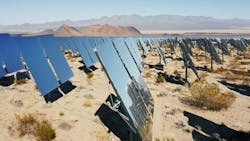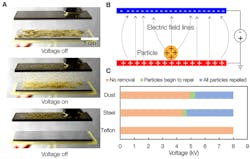Arrays of solar panels are often built in deserts where sunlight is plentiful and property is cheap. Unfortunately, dust and winds are also common in deserts, and dust on photovoltaic solar panels can reduce their electrical output by 30% after just a month of exposure to the weather. Even a 1% drop in power for a 150-MW solar installation could translate into a $200,000 loss in yearly revenue. Researchers say that globally, a 3 to 4 % reduction in power from solar plants would lead to $3.3 billion to $5.5 billion loss.
This makes regularly cleaning them essential.
But it’s estimated that cleaning solar panels currently requires about 10 billion gallons of water annually, enough to supply drinking water to a million people in developing countries. Keeping the panels clean without water is a labor-intensive proposition and can scratch and damage panel surfaces, which also reduces efficiency. To solve this dilemma a team of MIT researchers have devised a way of automatically cleaning solar panels, or the mirrors of solar thermal plants, without water or contact.
The new system uses electrostatic repulsion to make dust particles leap off the panels without using water or brushes. To activate the system, an electrode passes just above the panel’s surface, giving the dust particles an electrical charge. They are then repelled by a similar charge applied to a transparent conductive layer just a few nanometers thick, which is deposited on the solar panel’s glass covering. The researchers were able to find a voltage range that could overcome the pull of gravity and adhesion forces and make the dust lift away. The system can be automated using an electric motor and guide rails along the side of the panel.
Other engineers have tried developing electrostatic-based approaches to cleaning solar panels, but they usually relied on an electrodynamic screen and using interdigitated electrodes. These screens can have defects that let moisture in and damage the electronics. So, they might be useful on a place like Mars where moisture is not an issue, but on Earth—even in desert environments—this can be a serious problem.
In tests, the MIT team found that humidity in the air created a thin coating of water on the dust particles, which proved crucial to making the cleaning effort effective. They found that as long as humidity is greater than 30% all the dust is removed, but as humidity decreases, it becomes more difficult.
“The good news,” says Kripa Varanasi, a professor of mechanical engineering at MIT, “is that most deserts fall in the 30% humidity range. And even those that are typically drier tend to have higher humidity in the early morning, leading to dew formation, so cleaning could be timed accordingly.”
When scaled up, a small motor, perhaps using a tiny portion of the panel’s output, could drive a belt system to move the electrode across the panel. The process could also be automated or controlled remotely. Alternatively, thin strips of a conductive, transparent material could be installed above the panels, eliminating the need for moving parts.
See the dust-removal system in action below:


